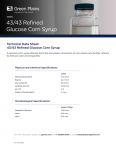Beta-glucan-rich fat replacers pass taste test for cookies: Study
While the replacement of fat in food products is an area of great interest for many in the food industry, the use such ingredients has been limited mostly to baked or dairy products, according to the researchers from Korea’s Sejong University, and the United States Department of Agriculture’s Agricultural Research Service.
“Therefore, there is still a need to extend the sources for fat/ flour replacement in a wider variety of foods which are necessary to meet the demand of consumers for novel and functional foods,” wrote the researchers, led by Kathleen Warner in the journal LWT- Food Science and Technology.
According to the findings of the team, the commercially available hydrocolloids Nutrim-OB and C-Trim20 could be used in cookies at a level of up to 20 and 10 per cent, respectfully, without detrimentally affecting the flavour and texture of the finished product.
Both formulations would provide a beta-glucan ‘dose’ of 0.5 grams per 100 grams of cookie, added the researchers.
“Even though this may not constitute a sufficient amount of b-glucan to make an FDA-approved health claim on a label, adding b-glucan-rich hydrocolloids to foods instead of fat/flour is a good way to improve health by increasing dietary fibres and reducing the calories,” they said.
The research taps in to the trend of fat reduction in products as consumers continue to seek out low-fat and low-calorie versions of their favourite foods.
Formulation details
Warner and her co-workers formulated cookies and peanut spread with the hydrocolloids. Different amounts of the hydrocolloids were used, and the maximum amounts that could be formulated into the cookies were 20 and 10 per cent for Nutrim-OB and C-Trim20, respectively.
For the peanut spread, Nutrim-OB was found to replace up to 13 per cent of the peanut flour and up to 5 per cent of the oil “without undesirable changes in flavour and texture”, said the researchers. .
For the C-Trim20 ingredient, the researchers report that up to 9 per cent replacement of peanut flour could be used in the production of acceptable products. Such replacement would reduce the caloric count of the peanut spread by 50 kcal per 100 grams.
Source: LWT - Food Science and TechnologyVolume 42, Issue 1, Pages 350-357“Flavor and texture attributes of foods containing β-glucan-rich hydrocolloids from oats”Authors: S. Lee, G.E. Inglett, D. Palmquist, K. Warner










